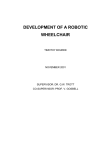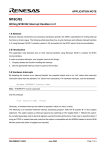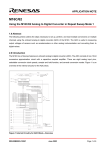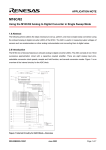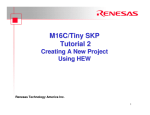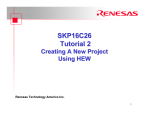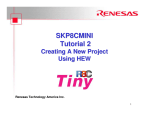Download Mitsubishi X30 Specifications
Transcript
www.m16canz.com MITSUBISHI M16C/62 MCU STARTER KIT BOARD (MSA0654-MEAUST) INSTALLATION PROCEDURE Version 2.0 06-Jun-02 Prepared by Alan Suyko 1 www.m16canz.com I. SOFTWARE TOOL VERSIONS: C Compiler: Integrated Development Environment: Debugger: Monitor Program: Flash programmer: NC30WA Version 5.00 Release 1 or later Tool Manager Version 3.11 or later KD30 Version 3.00 Release 1 or later Version 2.00 or later Flash Start Version 1.0.0.7 or later II. SOFTWARE TOOLS DOWNLOAD: 1. Uninstall all old M16C software tools in your PC that was installed from the M16C Starter Kit CD. The software contents on the M16C CD were mainly for our university student program and are no longer the latest versions. 2. Download the latest versions of NC30WA, TM, KD30, monitor program, start-up files and Flash programmer as well as text editor (optional). • NC30WA & TM: http://www.tool-spt.mesc.co.jp/trial/nc30ty_e.htm • KD30, Monitor Program, Flash Programmer, revised start-up files (ncrt0.a30, sect30.inc) for Ver 2.00 monitor program: www.m16canz.com • Text editor: EditPlus (shareware) www.editplus.com 3. Install all the above software. Make sure to install NC30WA first before TM as TM will auto-detect what compiler is installed in your system. NC30WA will ask you for a license ID, but without the license ID the compiler will still be installed on a 4 months trial period. 4. For the sample projects (e.g. sample3), copy the C source file (sample3.c) and the header files (leddata.h & sfr62.h) to a new directory. Make sure there are no spaces in the directory name since Tool Manager does not recognize spaces in file names and paths. 5. Copy the revised versions of ncrt0.a30 and sect30.inc downloaded from our web site to this new directory. Note that the interrupt vector addresses in the sect30.inc file has been modified based on the interrupt routine functions used in the sample C program (e.g _TimerA0int, _TimerA1int). NOTE: Make sure that the interrupt vector addresses in sect30.inc file are updated when using the other sample programs requiring other interrupts such as ADC, UARTs, etc. All unused interrupt vector addresses must be set to a ‘dummy_int’ label. 2 www.m16canz.com III. PROJECT CREATION PROCEDURE: 1. Run Tool Manager 3.11 (TM Project Bar). Create a new project by clicking the New Project button in the Project Bar. This will launch the Project Editor and Project Editor wizard. • PE Wizard Step 1: Select the Target chip (choose M16C Family) and specify a project name and working directory (directory name and path must have no spaces). • PE Wizard Step 2: Choose C project. • PE Wizard Step 3: - Choose compiler package NC30WA V.5.00 Release 1 by clicking on the pull-down menu. - Select a custom start-up program by specifying the ncrt0.a30 file located in your working directory. - Click the Next button. Your project will now be created using the specifications you provided in the above steps. • PE Wizard Step 4: Click the Finish button to create your new project. 2. Go to TM Project Editor. • Expand the project tree by clicking on the (+) symbol beside ‘all’. 3 www.m16canz.com • Select the .x30 file and add the C source file (e.g. sample3.c) to your newly created project by clicking the Add File button. Make sure the C source file is added under the .x30 file in the project tree by first selecting the .x30 file prior to clicking the Add File button. • Save the newly created project. 3. Go back to TM Project Bar. Click on the Build or Rebuild button to build the new project. The Builder window will be opened and will display the assembler, compiler and linker output data while building the new project. 4 www.m16canz.com 4. If no errors were found, you are now ready to debug your new project. IV. TEXT EDITOR SETUP: Tool Manager does not come with a text editor. However you may use EditPlus Text Editor which is a shareware text editor (www.editplus.com). EditPlus includes C syntax highlighting and accepts parameters from Tool Manager to jump to the error lines in your source files during build for faster debugging and development. 1. Register EditPlus in Tool Manager by clicking the Tool Register button in the TM Project Bar and selecting the Edit Tool tab. 2. Click the Add button and fill in the name, file path and parameter fields. For the parameter field, enter “-e %F –cursor %L” to allow you to open EditPlus automatically when clicking on the error message with line number information on the TM Builder window. 5 www.m16canz.com 3. Verify if EditPlus is setup correctly by going to TM Project Editor window and double clicking your C source file in the project file tree. EditPlus should automatically run and load your selected source file. V. KD30 DEBUGGER SETUP: The KD30 debugger software installed in your PC talks to the monitor program written the M16C/62 Flash on the target board via serial cable in order to perform its debugging functions. The monitor program provides KD30 with the debugging information it displays in its various windows. To write the monitor program to the M16C/62 Flash on the SK board, the Flash Start programming software is used. M16C/62 Flash with Monitor Program KD30 6 www.m16canz.com Flash Start Setup 1. Register Flash Start in Tool Manager by clicking the Tool Register button. 2. Select the Application tab and fill in the Name and File Path fields. 3. Click the OK button. Flash Start will now be available from the TM Project Bar. Monitor Program Installation 1. The Starter Kit board will normally be delivered without the monitor program installed. To install the monitor program, set up the Starter Kit board by connecting the 9-pin serial cable to the SK DB9 connector and to the PC RS-232 port. 2. Prior to connecting the DC power supply to the board (either 9V or 5V), make sure that the CNVss jumper is fitted (located next to the 9V socket). This will allow the M16C MCU to startup in “boot” mode where the CPU starts operating using the standard serial I/O control program in the boot ROM area. This control program allows the Flash ROM to be programmed via the serial I/O port. 7 www.m16canz.com 3. Connect the DC power supply (either 9V or 5V) to the board. The black DC socket is centerpositive and accepts DC voltage ranging from 8-12V. If a 5V regulated DC power supply is available, use the DC screw-in terminal block. Set jumper JP8 accordingly such that LED D2 is lit when power supply has been applied to the board. 4. Once the SK board has been powered up, run the Flash Start program. 5. Enter the path of the monitor program object file in the FilePath field and enter all “00” on the ID field. 8 www.m16canz.com 6. From the main menu below, click on Setting to change the baud rate to a faster speed. If you are using a 16MHz crystal on board the SK, you may try setting the baud rate up to 57600 bps. If communication error is observed when using Flash Start, you may selecting a slower baud rate. 7. Click on the Erase button to erase the Flash ROM. 9 www.m16canz.com 8. Click the BPR button to perform Blank Check, Program and Read Check on the specified address range (0FE000 to 0FFFFF) for the monitor program. 9. After the BPR operation is completed, exit the Flash Start program by clicking the Exit button. 10. Remove power on the SK board and remove the CNVss jumper. 11. Reapply power to the SK board. The SK board should now operate in normal mode. With the monitor program now in place it should be able to communicate with KD30 Remote Debugger. KD30 Debugging 1. Go to TM Project Bar and click the Debug button. 10 www.m16canz.com 2. When this is done for the first time, TM will ask you to select a debug tool. Make sure KD30 is already installed prior to performing this step. Select KD30. Click the OK button. 3. KD30 will now be executed. Click the OK button in the KD30 Init window. 4. With a project opened from the TM Project Bar, KD30 will automatically load the project files. For manual download, click on File->Download->Load Module in your project working directory. 11 www.m16canz.com Once the project files are downloaded to KD30, you are now ready to perform your code debugging and evaluation in KD30 using its many debugging features. VI. STAND-ALONE MODE DEBUGGING With the target program in the project now fully debugged under KD30, it is now time to create a machine language file in Motorola S format to write the target program into the M16C/62 Flash on the SK board. This will allow the target program to be debugged in stand-alone mode (i.e. without KD30 & monitor program). Currently the target program is still in absolute module file (.x30) format as created by the linker ln30. To convert the absolute module file (.x30) to a machine language file in Motorola S format (.mot), the lmc30 utility is used. LMC30 Setup 1. Register LMC30 in TM by clicking the Tool Register button in TM Project Bar. 2. Select the Application tab in the Tools Information window and click the Add button. 3. In the Application Information window: a. Enter ‘lmc30’ in the Name field. 12 www.m16canz.com b. Enter the file path of lmc30 (normally C:\Mtool\BIN\lmc30.exe). c. Enter ‘%X’ in the Parameters field. This will pass the target program name to lmc30. d. Click the OK button. LMC30 will now be created in the TM Project Bar. 4. Run LMC30 from the TM Project Bar. This will now automatically create the machine language file in Motorola S format (.mot) from the absolute module file (.x30) in your project directory. Writing the Target Program to M16C/62 Flash in the SK Board 1. Set up the SK Board as in Monitor Program Installation procedure and make sure that the CNVss jumper is on. 2. Run the Flash Start program from the TM Project Bar. Load the machine language file (*.mot) and type all “00” on the ID field. Click the OK button. 13 www.m16canz.com 3. Click on the Erase button to erase the Monitor Program contained in the Flash ROM. 4. Click the BPR button to perform Blank Check, Program and Read Check on the specified address range (e.g. 0C0000 to 0FFFFF for sample2.mot) for the target program. 5. When the BPR operation is completed, remove the power on the SK board and remove the CNVss jumper. Reapply power and the target program should start executing immediately. 14















